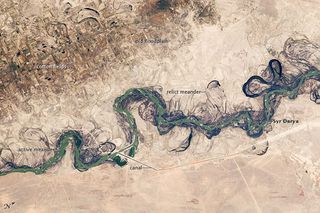
Meandering River Marks Alexander the Great's Northernmost Reach

Central Asia's most important cotton-growing region is concentrated in the floodplain of the Syr Darya River in Kazakhstan.
The river was one of the farthest points reached by the ancient Greek leader Alexander the Great, marking the northernmost limit of his conquests.
In this image, the floodplain is shown as a tangle of twisting meanders and loops. The darkest areas are brushy vegetation along the river's present course; wisps of vegetation are also visible along flanking swampy depressions, called sloughs.
An older floodplain can be seen as more diffuse dark vegetation, where older bends are overlain by a rectangular pattern of cotton fields. In contrast to the intensive agricultural use of water shown here, water control in the mountain valleys upstream is oriented more toward power generation.
The river flows for 1,367 miles (2,200 kilometers) from the Tien Shan Mountains to the Aral Sea, whose water has been withdrawn from the river for agriculture for decades. Currently, Syr Darya is the second largest river flowing into the Aral Sea.
While the Syr Darya drains an area of over 310,000 square miles (800,000 square kilometers), no more than 77,000 square miles (200,000 square kilometers) actually contribute significant flow to the river, so the river is easily depleted.
Control of the river is vested in the Syr Darya Basin Water Organization, run by nations with territory in the watershed. Some of the organization's main efforts include accurate gauging of water use and repair of canals to reduce widespread water leakage. Half the river flow is controlled from reservoirs, and half from direct water take-off from canals.
Sign up for the Live Science daily newsletter now
Get the world’s most fascinating discoveries delivered straight to your inbox.
Alexander the Great reached the Syr Darya in 329 BCE. On the north bank of the river (just beyond the lower left of this image) his army clashed with the local nomads. The river is consequently better known in the West by its Greek name, Jaxartes. From here, Alexander marched south through Afghanistan to the Indus River plains in Pakistan before starting the long march back. He died before reaching his homeland.
Most Popular


